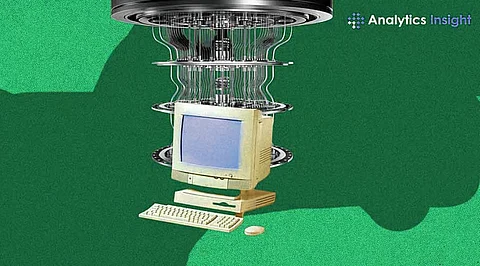Business
Quantum Computers Gain Ground in Reliability, Yet Trust Remains Elusive

Quantum computers are advancing rapidly, showing potential to revolutionize complex problem-solving. Their ability to perform calculations that would take classical computers thousands of years is drawing increasing interest. Yet, doubts linger regarding their reliability. While improvements in error correction and verification techniques have been made, many experts argue that full trust in these systems remains a distant goal.
At the heart of quantum computing are qubits, which can exist in multiple states simultaneously. This unique property enables quantum computers to explore numerous possibilities at once. However, qubits are inherently fragile. Small disturbances can cause them to lose their quantum state, leading to issues like decoherence, where external factors such as temperature changes and electromagnetic interference degrade their performance. Furthermore, quantum gates, which perform operations on qubits, can also introduce errors, complicating the reliability of outputs.
Enhancing Reliability Through Research
Researchers are focused on making quantum computations more trustworthy. One significant approach is quantum error correction, which spreads a single logical qubit across multiple physical qubits. This method allows for the detection and correction of errors before they affect the final results. Despite its promise, this technique requires a substantial number of qubits, presenting a notable challenge for current technologies.
Presently, many quantum devices rely on error mitigation strategies to combat the effects of noise without the resources needed for complete error correction. Techniques such as statistical methods and adaptive pulse shaping enhance the accuracy of quantum gate operations. These advancements help to produce more reliable results, thereby gradually building confidence in the technology.
Navigating the Verification Challenge
Verification remains a critical hurdle for quantum computing. The sheer volume of potential solutions generated by these systems often exceeds the capabilities of classical computers to validate them, leading to what is known as the “black box” issue. To address this, scientists are employing various verification methods. Some protocols incorporate “trap” calculations within complex tasks, allowing researchers to gauge the reliability of results. If a quantum computer fails to meet the criteria set by these traps, the outputs are deemed less trustworthy.
A notable development comes from Swinburne University, where researchers crafted a classical validation method for Gaussian Boson Sampling experiments. This technique can verify results in minutes, a task that would otherwise take classical machines thousands of years. Hybrid quantum-classical systems are also emerging as a solution, enabling comparisons of intermediate steps to ensure accuracy throughout the computational process.
Quantum advantage is a pivotal metric in assessing trust in quantum systems. It indicates a quantum computer’s ability to solve real-world problems more efficiently, cost-effectively, or accurately than classical systems. In contrast, quantum supremacy merely demonstrates a quantum system’s capability to address problems beyond the reach of classical computers. Users will only gain full confidence in quantum computing when systems consistently deliver verified and practical solutions.
Major players in the quantum computing field, such as IBM and Google, are actively enhancing both hardware and software components. Progress in qubit coherence is particularly noteworthy, as improved coherence times contribute to more stable operations. Initiatives to reduce gate errors and implement real-time error correction are also underway. For example, Google’s Willow chip has demonstrated low error rates even with over 100 qubits, showcasing the strides being made in reliability.
Despite these advancements, quantum computers are not yet the ultimate solution for all computational challenges. The inherent fragility of qubits, their sensitivity to noise, and the probabilistic nature of their outputs necessitate careful verification. Full fault-tolerant quantum systems capable of correcting all errors autonomously remain years away. Until then, cautious interpretation of results and thorough verification are essential.
As the field of quantum computing continues to evolve, the potential for groundbreaking applications in areas such as optimization, cryptography, and material simulations grows. The path to reliable quantum answers is being paved through ongoing research and development, which will ultimately shape the future of this transformative technology.
In conclusion, while quantum computers possess extraordinary capabilities, users must approach their outputs with a discerning eye. Advances in verification methods and hardware improvements are gradually enhancing their reliability. As technology progresses, confidence in quantum computing is expected to rise, expanding its role across various sectors in science, industry, and research.
-

 Science2 weeks ago
Science2 weeks agoIROS 2025 to Showcase Cutting-Edge Robotics Innovations in China
-

 Politics2 weeks ago
Politics2 weeks agoJudge Considers Dismissal of Chelsea Housing Case Citing AI Flaws
-

 World2 weeks ago
World2 weeks agoBravo Company Veterans Honored with Bronze Medals After 56 Years
-

 Top Stories2 weeks ago
Top Stories2 weeks agoIndonesia Suspends 27,000 Bank Accounts in Online Gambling Crackdown
-

 Lifestyle2 weeks ago
Lifestyle2 weeks agoStone Island’s Logo Worn by Extremists Sparks Brand Dilemma
-

 Sports2 weeks ago
Sports2 weeks agoMel Kiper Jr. Reveals Top 25 Prospects for 2026 NFL Draft
-

 Health2 weeks ago
Health2 weeks agoStartup Liberate Bio Secures $31 Million for Next-Gen Therapies
-

 Health2 weeks ago
Health2 weeks agoTop Hyaluronic Acid Serums for Radiant Skin in 2025
-

 World2 weeks ago
World2 weeks agoHoneywell Predicts Record Demand for Business Jets Over Next Decade
-

 Politics2 weeks ago
Politics2 weeks agoNew Jersey Voters Urged to Register Ahead of November Election
-

 Lifestyle2 weeks ago
Lifestyle2 weeks agoMary Morgan Jackson Crowned Little Miss National Peanut Festival 2025
-

 Sports2 weeks ago
Sports2 weeks agoYamamoto’s Mastery Leads Dodgers to 5-1 Victory in NLCS Game 2







